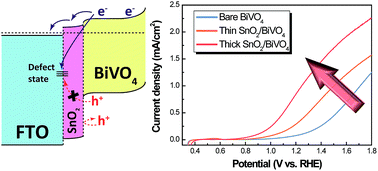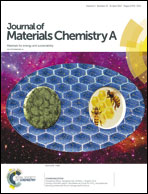Effects of a SnO2 hole blocking layer in a BiVO4-based photoanode on photoelectrocatalytic water oxidation†
Abstract
Bismuth vanadate (BiVO4) has emerged as a promising photoanode for photoelectrochemical (PEC) water splitting due to its appropriate band edge positions for an oxygen evolution reaction (OER). However, poor charge transport and slow kinetics for an OER when used alone without a buffer layer have prevented BiVO4 based photoanodes from achieving a high PEC performance that was theoretically expected. Here, we investigate the effects of a SnO2 buffer layer in BiVO4 based photoanodes; in particular, how varying the thickness of the SnO2 layer affects the properties of the materials in the SnO2, the BiVO4 grown on top of the SnO2 and the PEC performance for water oxidation. To our surprise, a simple change of the SnO2 thickness resulted in substantial changes in the intrinsic properties of the BiVO4, including the Bi/V stoichiometry, crystalline phases, grain size, film roughness, and even the band gap, all of which are relevant to the operation of PEC cells. With an optimal SnO2 thickness, much enhanced PEC performances of SnO2/BiVO4 photoanodes were obtained; the photocurrent density of 0.95 and 3.76 mA cm−2 (measured at 1.23 V vs. the reversible hydrogen electrode (RHE) under 1 sun illumination) was demonstrated for the water and sulfite oxidation reactions, respectively. Our findings emphasize the importance of tuning the properties of the buffer layer, which subsequently influences the material properties of BiVO4, in achieving high PEC performance of BiVO4-based heterojunctions.



 Please wait while we load your content...
Please wait while we load your content...